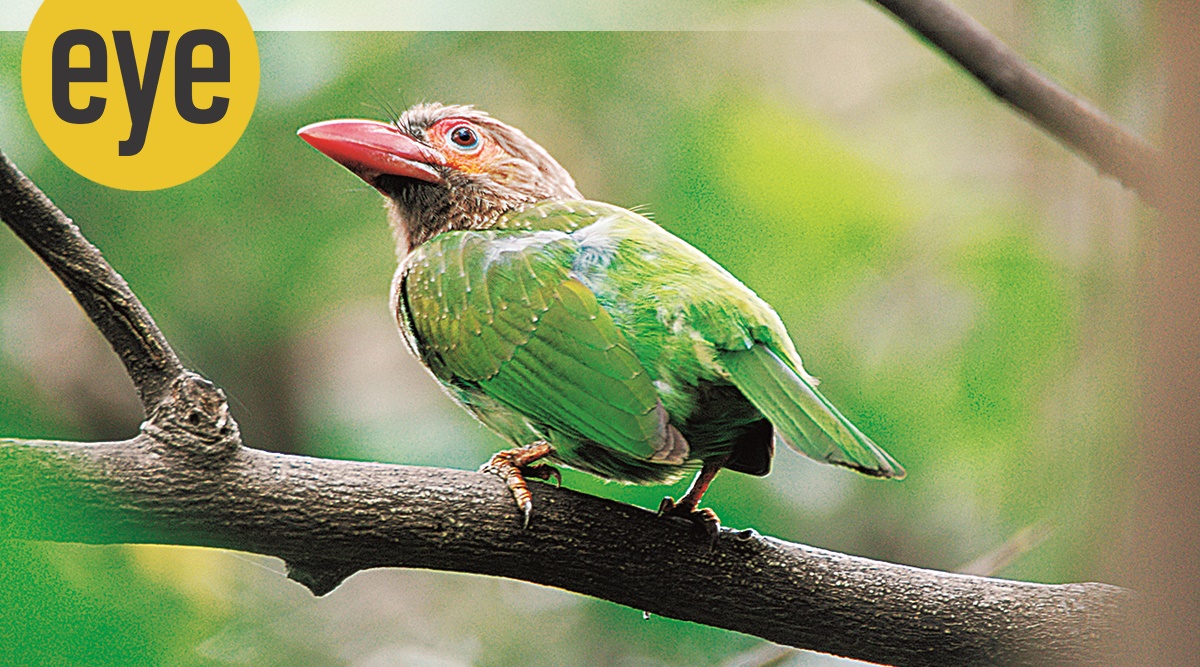 Spring Songs: A brown-headed barbet loudly heralds the season
Spring Songs: A brown-headed barbet loudly heralds the season ALL THROUGH the last week of January, I had kept my ears cocked for it, to no avail. Did this mean another numbing cold wave was on its way? Then, at the turn of the month I heard it: a single bird — brown-headed barbet — calling with confidence, “Kutroo! Kutroo! Kutroo!” and loudly heralded the onset of spring.
Anticipating the coming summer, it called non-stop. All too soon, it was joined by a team of compatriots and the decibel reached midsummer levels. I have learnt to trust them more than I do the forecasts and know now that winter is finally on the wane. It is a rustic-looking grass-green bird, about the size of a myna, that melds into the foliage and has an endearing, slightly oafish expression. With chrome yellow on its face and a large red bill, it appears to be grinning all the time.
It was soon joined by its tubbier cousin, the clown-faced coppersmith, who, on sensing spring and summer, began to hiccup with delight. All these calls are reminders to get on with life — excavate a nest hole, win over a partner (fight for both, if necessary), and raise a brood or two.
The mellifluous red-whiskered bulbuls flit from branch to branch like exclamation marks, standing straight as guardsmen. They’ve begun pairing and diving headlong into hedges like eager new lovers, probably seeking a safe location for their nests. The rose-ringed parakeets just keep on their raucous squawking year-round. The mynas start off with a civilised debate, which disintegrates into a disgraceful shrill, rugby scrum, and, then, all-out fisticuffs in which several birds gleefully take part.
My old friends, the jungle babblers in their khaki drill, come visiting the portico every afternoon, hopping furtively, uttering soft but harsh comments, turning over dead leaves. Suddenly, the whole band of them, seven or eight, breaks out into an almighty cacophony which compels you to move to your room. And, then, with equal suddenness, they all go quiet and flit away.
The purple sunbird checks out the premature bottlebrush blossoms (the tree is in full bloom in mid-March) while uttering snatches of his song.
The treepies come around regularly every afternoon, demanding “thocolate”: their voice is a strange mixture of dulcet and harsh. Keep your ears cocked and you might catch the soft wheezy-whistles of green pigeons well hidden in the peepul tree just beyond the cemetery wall — it’s a strangely calming lullaby call. The laughing dove croons sleepily all afternoon — and this one can really make you doze off.
The solemn-looking monocled white-eyes keep up their soft jingling refrain in the background like a soothing chorus. They are diminutive sulphur-yellow birds with a white ring around their eyes, and can be difficult to winkle out of the foliage. So far, the tailorbird has been circumspect with its calls, happy to flit from twig to twig, uttering its “chiwit-chiwit” calls softly as it snaps up tiny insects.
That great maestro — the magpie robin — is around but apart from an occasional long whistle and a misanthropic “chrrr!”, it has not broken into song yet.
From time to time, that little hunting hawk, the shikra emits its shrill “ki-keee” call from the cemetery and the daft-looking grey hornbills squeal delightedly from one neem tree to another. A koel, too, yodeled out, premature in its anticipation of the monsoon, perhaps. What I have missed so far are the cheerful spirit-lifting calls of the grey francolin (partridge) — “pateela! pateela! pateela!” — from the cemetery across the wall. I wonder whether it’s a case of local extinction or that the families have migrated across the road to the Qudsia Bagh next door.
It is generally believed that the best time to listen to birds sing, and welcome spring and summer, is in the early mornings (dawn chorus) or in the evenings, when they return to the trees to roost, bursting with the day’s gossip. But, time and again, I have found mid-afternoon to be as good a time as any. Periods of quiet are first broken by a few individuals, say, the barbets calling from posts high up on the trees, then more join in — the babblers and mynas — and, soon, there’s an exuberant racket going on. At the time of writing, it is pleasant to sit out in the sun in the afternoon and to listen and watch, even if this distracts you no end from what you are reading. And then, as the excited chatter suddenly dies down, as it is wont to do, all you can hear is the sleepy, soft “cuoon-cuoon-cuoon” call of the laughing dove, and your eyelids droop, your head nods and you doze off deliciously.
 Continue with Facebook
Continue with Facebook Continue with Google
Continue with Google